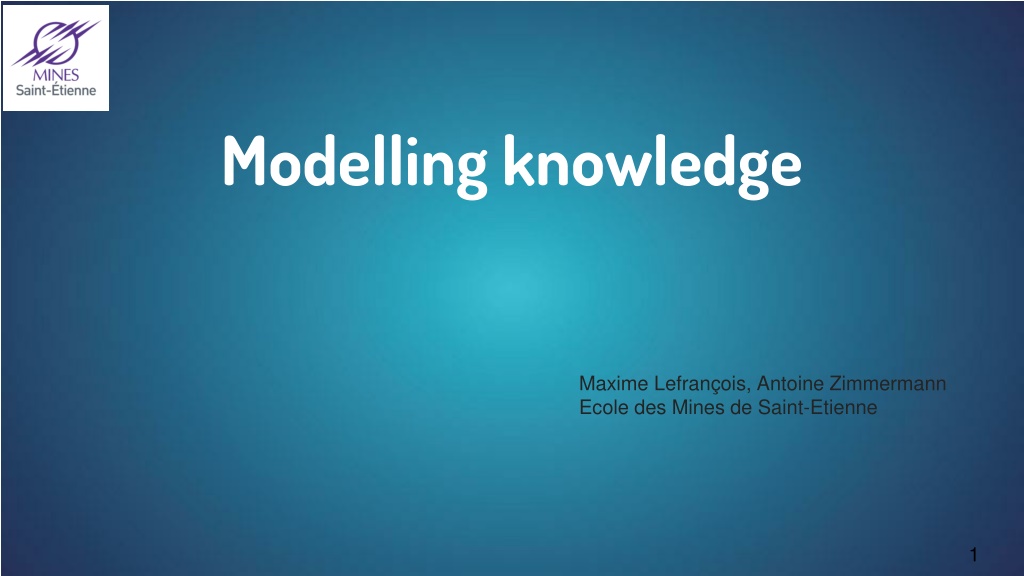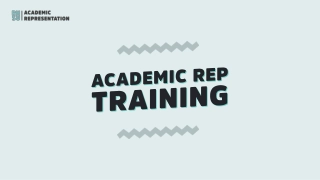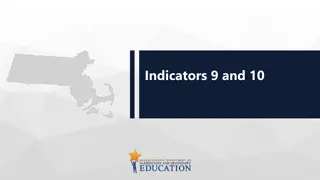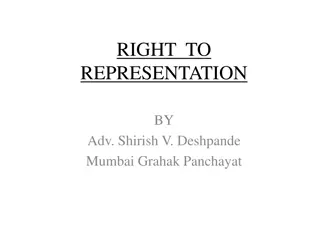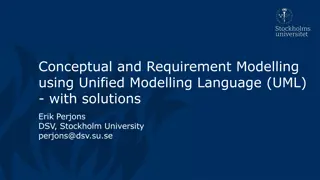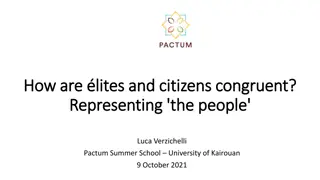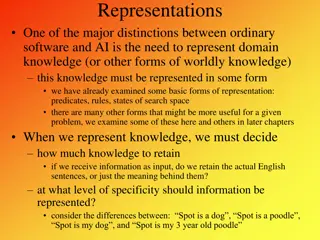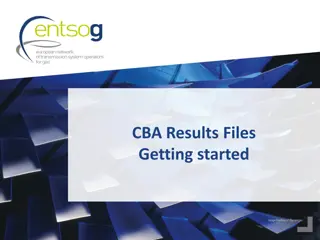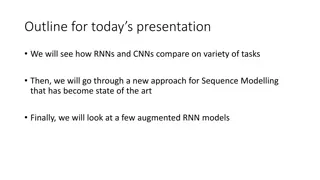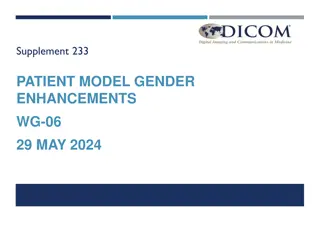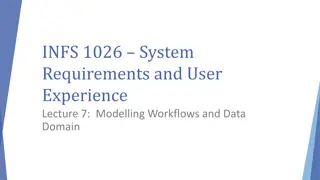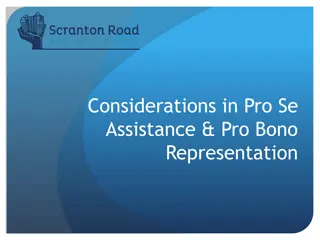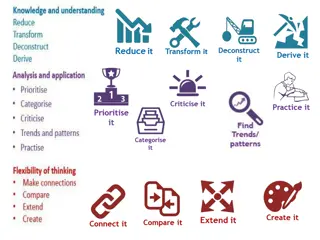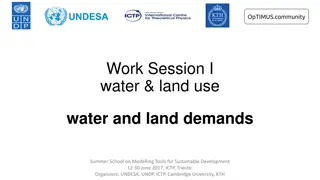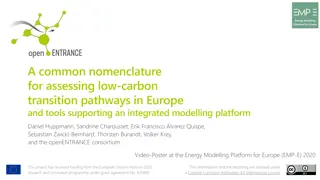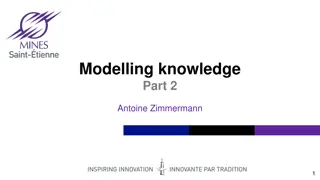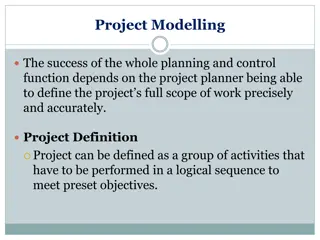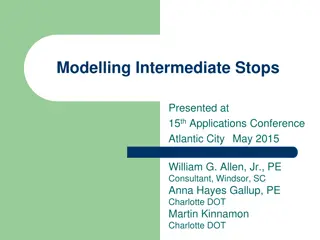Understanding Modelling Knowledge and Knowledge Representation
Explore the significance of modelling knowledge through knowledge representation, making it explicit, independent, and reusable. Learn why knowledge representation is essential and how it facilitates exchange, query, inference, and visualization. Delve into examples of knowledge application in various domains and distinguish between data, information, and knowledge. Discover what specific data, conclusions, and general knowledge entail, and understand the scope of the course on modelling knowledge.
- Modelling Knowledge
- Knowledge Representation
- Data Interpretation
- Knowledge Application
- Information Exchange
Download Presentation

Please find below an Image/Link to download the presentation.
The content on the website is provided AS IS for your information and personal use only. It may not be sold, licensed, or shared on other websites without obtaining consent from the author. Download presentation by click this link. If you encounter any issues during the download, it is possible that the publisher has removed the file from their server.
E N D
Presentation Transcript
Modelling knowledge Maxime Lefran ois, Antoine Zimmermann Ecole des Mines de Saint-Etienne 1
Content Introduction Classification Graph-based knowledge representation 2
Introduction Why modelling knowledge? make knowledge explicit make it independent from a specific system reusable in different systems derive implicit information from explicit knowledge and facts Why knowledge representation Answer common needs that arise with the produced knowledge -> exchange, query, infer, visualize ... 3
Introduction Examples : an app for learning how to cook and invent new recipes, and a recipe search engine require knowledge about cooking and recipes. a electric vehicle charging planner requires knowledge about the charging station, the driver needs, the electricity price.. 4
Introduction KR is applied to other domains 5
Introduction Knowledge vs. data vs. information Data are just values (e.g., 19.2, foo , 2016-04-07), possibly in a structure (e.g., a table) Information is what data is when interpreted by way of knowledge (e.g., 19.2 is the temperature in C in a room at a certain time) Knowledge is what makes data into information (I know that the sensor is a thermometer that has just stayed in my living room at 8 pm) 6
Introduction Specific data (e.g., Harry Potter and the Philosopher's Stone is a novel) Conclusions (e.g., Harry Potter and the Philosopher's Stone is a narrative) General knowledge (e.g., A novel is a narrative) + = 7
What is this course not about? Modelling knowledge is a task that is part of the field of knowledge representation and reasoning (KR&R). In this course we do not: talk much about reasoning and the links between KR&R and logic (this is the topic of a course on logic or on AI) discuss how knowledge-based systems are implemented cover all techniques of knowledge modelling 8
This course is ... new, so it is going to evolve as it goes please provide feedback early on (hopefully) minimally overlapping with things you ve already seen but has strong connections with: the first year course on logics the AI toolbox the course on Semantic Web in the Computer science Major 9
Exercise What kind of knowledge do you need for cooking? Think of what would a robot need to do cook. What a person needs to find recipes that are appropriate for them? What knowledge is needed that can be used in other fields? 10
Classification systems Tree of Portphyry, 3rd century AD, representing Aristotle categories 11
Classification systems Biological taxonomy 12
Classification systems Library classification 500 Natural sciences and mathematics 510 Mathematics 516 Geometry 516.3 Analytic geometries 516.37 Metric differential geometries 516.375 Finsler Geometry 13
Classification systems General knowledge: Persons are Living-beings Specific data: Aristotle is a Person Conclusion: Aristotle is a Living-being In first order logic: x.Person(x) Living-being(x) Person(Aristotle) Living-being(Aristotle) 14
Classification systems: guidelines A name can only be used for one class A word does not necessarily correspond to a class and vice versa Use consistent naming convention (e.g., capital letters, singular nouns or noun phrases) Define classes by analogy: similar structure, similar features 15
Classification systems: exercise D finir une hi rarchie partir des concepts suivants : Athl thisme, Course, Football, FootballAm ricain, Natation, NatationSynchronis e, Patinage, PatinageArtistique, PatinageDeVitesse, Relai, Ski, Sport, SportArtistique, SportCollectif, SportDeBalle, SportIndividuel, Tennis. 16
representation Classes are not enough to represent most knowledge Relations between entities are required E.g., what ingredients are in a dish? 17
representation Representing entities and their relationships: mind maps topic maps semantic networks conceptual graphs RDF 18
representation Semantic networks: Describe particular entities e.g., John knows Sam and is the son of Henry John Sam Henry In FOL: knows(John,Sam) son-of(John,Henry) 19
representation Exercises: describe pizza recipe as a semantic network how to describe the pizza that I made yesterday? 20
representation Add two special relationships is-a (between an entity and a class it belongs to) kind-of (between a class and a superclass) Person Living-being John Henry 21
representation Meaning of is-a and kind-of We would like that this graph: Person Living-being John Henry logically implies: Living-being John 22
representation Meaning of is-a and kind-of First interpretation: C e means in FOL: C(e) for any e and C C D and means: x.C(x) D(x) Problem: in this case, C is a predicate symbol and e is a constant but in the graph, they are both nodes. Nodes that are classes should be distinguished from nodes that are entities 23
representation Meaning of is-a and kind-of Second interpretation: if C e D then D e In FOL: e C D.is-a(e,C) kind-of(C,D) is-a(e,D) 24
representation Exercise: Complete your description of the cooking knowledge model with is-a and kind-of 25
Graph representation: generalising We have seen a formalism that can express that a particular recipe (e.g., my mom s omelette) has particular ingredients (e.g., 4 eggs). How do we represent the fact that recipes, in general, have ingredients? Recipe Ingredient ? myMumOmelette fourEggs 26
Graph representation: generalising There are several interpretations of the relationship between classes Recipe Ingredient The class Recipe itself relates to the class Ingredient by relation hasIngredient hasIngredient(Recipe,Ingredient) All recipes have some ingredients x. y.Recipe(x) Ingredient(y) hasIngredient(x,y) or x. y.is-a(x,Recipe) is-a(y,Ingredient) hasIngredient(x,y) Recipes may have ingredients 1) 2) 3) 27
Graph representation: generalising There are several interpretations of the relationship between classes Recipe Ingredient The relation hasIngredient only relates recipes to ingredients x. y.hasIngredient(x,y) Recipe(x) Ingredient(y) or x. y.hasIngredient(x,y) is-a(x,Recipe) is-a(y,Ingredient) 4) 28
Unknown values What if I want to describe a recipe for which I do not know the cooking time? What if I want to say something about a recipe that does not match a property of the class? Open World Assumption vs. Closed World Assumption 29
Expressiveness vs. Complexity tradeoff Expressiveness comes at the cost of complexity: Complexity of design Complexity of understanding Complexity of computation Principle of least power: Always choose the least expressive language that suits your purposes 30
